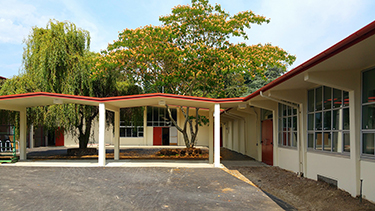|
Subscribe / Renew |
|
|
Contact Us |
|
| ► Subscribe to our Free Weekly Newsletter | |
| home | Welcome, sign in or click here to subscribe. | login |
Construction
| |
 |
August 20, 2015
Landmark Paul Thiry school reopens to students after 34 years
Studio Meng Strazzara

Erwood
|
In just a few days, schools will spring to life as students and teachers fill classrooms and hallways, beginning the journey of another school year.
In preparation, school districts across the region have been working diligently to address classroom space issues resulting from growing student enrollment. Districts are adding portable classrooms, building new facilities and modernizing others. Some districts are also breathing new life into closed schools.
Cedar Park Elementary School, located in Seattle’s Lake City neighborhood, opened in 1959 as a response to the rapid increases in district enrollment that occurred in the 1950s. At its peak the school had 437 students, but by 1981 the student population had dwindled to 197. The school was then closed and the remaining students were moved to nearby schools.
The property was then leased to the Cedar Park Arts Center, later called Artwood, which used the building as artists’ residences and studios until 2014.
The artist community was a great steward of the property and the love they felt for the place was evident as you walked the site and building. But rapid growth in the Seattle Public Schools’ student population has required the district to build new schools and reopen others that have been closed for decades.
Our office has been working with Seattle Public Schools to reopen two such schools, North Queen Anne School and Cedar Park Elementary.
Cedar Park Elementary was designed by the noted architect Paul Thiry, one of the fathers of Northwest modernism. He was the supervising architect for the Seattle World’s Fair and designed the Washington State Pavilion — later renamed the Seattle Center Coliseum and now known as KeyArena. The school is designated as a Seattle landmark in large part for its innovative structural system.
Inventive upgrades
While the exposed and regularly spaced precast concrete frames, tilt-up concrete walls and precast concrete roof panels exemplify Northwest modernism, they created challenges in the renovation.
The structure also required seismic upgrading. Traditional reinforcing methods would not work due to the nature of the original design, so fresh ideas were needed.
Carbon fiber reinforcing was added to the top and bottom of the concrete roof panels, and the concrete columns were wrapped with it as well. This new approach allows the structure to meet current codes while retaining the character of the original design.
The building’s walls and ceilings were insulated, and the mechanical systems were replaced with energy-efficient systems that provide ventilation for better indoor-air quality and greater comfort. The structure created some additional difficulties, as most areas have no ceiling space in which to conceal ductwork and sprinkler piping. Electrical upgrades included the replacement of power and lighting, and the addition of low-voltage systems for fire alarm, security and data.
Large expanses of glazing span between the concrete frames, and are a key architectural feature. The glazing is divided into square panes by aluminum frames; the original windows were of flat-bar construction with single glazing and stopped in with asbestos containing putty. The design created a unique triangular frame appearance from the exterior.
New, highly energy-efficient double-glazed aluminum windows replaced the original. There are no commercial extrusions made today that match the original windows, so we worked with a window manufacturer to come up with a solution that takes off-the-shelf parts from different window systems to create triangular-shaped window frames that are nearly identical to the original.
In addition to design and structural enhancements, the school needed more classroom space. Working with the Seattle Landmarks Preservation Board, custom design modifications were added to standard classroom portables to complement the school’s architecture without distracting from the overall building and site configuration.
Artwork remains
Roadway improvements, new sidewalks, parking and student drop-off/pick-up areas were constructed.
Seattle Parks and Recreation leases the western portion of the site from the school district. It was originally a large asphalt playfield that was in disrepair after the school closed, but several years ago it was transformed into a neighborhood park, largely due to the efforts of the Artwood tenants and neighboring community members. The park will continue to serve the community and will be used by the students during recess.
Some of the artwork created by the Artwood artists in their studios at Cedar Park is incorporated into the design, providing students and the community another connection to the site’s history.
When it opens this September, Cedar Park School (as it is now named) will house students and staff from Olympic Hills Elementary School while their building is being replaced with a newly constructed school. After two years, the Olympic Hills students will move into their new school and Cedar Park School will go back to its original use as a neighborhood elementary school.
Dennis Erwood is a principal leading the education studio at the Seattle-based architectural firm Studio Meng Strazzara.
Other Stories:
- You can have a safe school theater — even on a budget
- New Vancouver high school prepares students for careers in health care
- Students have their say in Seattle school project
- High-tech tools help contractors keep up as school construction booms
- The grass is actually greener for schools that install synthetic turf
- A ‘third place’: where students can be themselves
- Six trends shaping the future of campus design
- Bellevue College will open its first on-campus housing in 2018
- How to make existing schools healthier, more efficient
- How to design schools to prepare kids for careers that don’t exist yet



